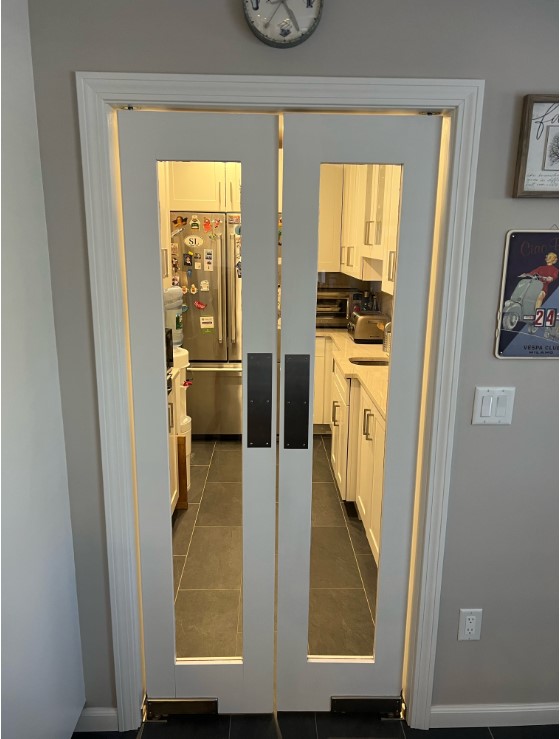
Elegance in Motion: Architectural Innovations with Swinging French Doors
Elegance in Motion: Architectural Innovations with Swinging French Doors
'Doors,' as the architect William Richards aptly put it, 'are the handshake of the building with the public.' And within the expansive repertoire of architectural handshakes, swinging doors - those elegantly simple yet functional devices - have long held considerable sway. From grand Renaissance palaces to the streamlined homes of the modern era, the swinging door has remained a steadfast ally to space efficiency, privacy, and aesthetic appeal. This post dives into the intrinsic role of swinging doors in architecture, examining the functional and design implications they offer to different styles and eras.

Evolutionary Trends in Historical Entrances
The history of architecture is replete with moments when doors were not merely points of passage but symbols of innovation and cultural shifts. In ancient Roman times, the bi-fold door was a revered feature, facilitating grand entrances and offering a glimpse into the opulence of the abodes beyond. In juxtaposition, medieval Europe saw a resurgence of heavy, wooden single-leaf doors, laden with wrought iron and stout fortitude, befitting the defensive nature of castles and manors.
Architectural Applications of Swinging Doors
The advent of the swinging door brought with it a new sort of fluidity to established architectural norms. With its hinge-mounted independence from the jamb, the swinging door presented architects and designers with an adaptable tool that could orchestrate larger, more accessible entryways or discreet, inconspicuous transitions within a space.
Incorporating Swinging Doors in Building Design
Balancing function and form, swinging doors became integral to building design. They were featured in saloons of the Old West and in aristocratic parlors where invisibly-hung variants were used for private anterooms and studies. The intention was clear - to control the passage of sound and movement with suave efficacy that could only be achieved through the unhurried, dignified swing of a door on its hinges.
Swinging Doors and Architectural Innovation
When architects of the Industrial Revolution sought to break away from the stifling opulence of the past, they found a new ally in the simplicity of the double French swinging door. Incorporating the key machinery of the era - ball bearing hinges and precision-cut woods - swinging doors leaped forward in design and practicality. Escaping the weight and creaking of their predecessors, these doors became lighter, easier to use, and represented a bright new future for architectural design. The French-style double swinging doors, allow extra light and grandness to be shown thru the tall glass of the doors. The glass can be frosted or clear glass allow for the beautiful entrance to your space.
Designing with Swinging Doors in Mind
Architects of the era began to design spaces with the fluid motion of the swinging door in mind. They considered the implications of entrances that could open with a gesture, allowing for a seamless flow of air and light. These considerations were not only utilitarian but philosophical, as doors came to represent a transition into a new, more open era. The double-action feature allows the doors to swing in both directions and automatically return to the center.
Architectural Integration of Swinging Doors
Swinging French doors became an emblem of the burgeoning Art Nouveau and Art Deco movements. Cleaved into geometric patterns or adorned with stained glass, they reflected the influence of both nature and technology in designs that celebrated the modern age. These doors graced the interiors of grand hotels, theaters, and apartments, inviting a dance of motion within the immobile walls of the city.
Aesthetic Impact: Swinging Doors in Architecture
Beyond their functional role, swinging doors have had a significant impact on the aesthetic of architecture. The decision to include a swinging door or not was often one of allegiance, signaling an architectural intent that could range from the rustic charm of a farmhouse kitchen to the stately elegance of a ballroom entrance.
Swinging Doors for Modern Architectural Styles
The modernist movement was marked by a stark, unadorned aesthetic that embraced transparency and simplicity. Accompanying this shift, the swinging door took on a purist form - a tall, unbroken pane of glass, say, that could swing open to join the outdoor space with the indwellers' own.
Traditional Architecture and Swinging Doors
Meanwhile, in traditional revival architecture, such as the Colonial Revival style, swinging doors maintained a role in preserving the historical continuity of design. They bore the hallmarks of meticulous craftsmanship, solid and weighty, maintaining a fidelity to the period they represented.
Swinging doors in architecture are much more than props for dramatic entrances. They are vital design features that regulate the ebb and flow of life within a building, balancing the need for openness with the demand for privacy. For architects and designers, understanding the motion and impact of a swinging door is to wield a potent element of architectural storytelling that reverberates through the building's very structure. It is this nuanced appreciation that continues to make swinging doors not just a necessity but an artful and timeless component of architectural design.
Contemporary Trends: Swinging Doors in Buildings
In the contemporary era, swinging doors have seen a resurgence as markers of bespoke, artisanal design. Not confined to any one style, they are embraced for their timeless appeal, fluid functionality, and ability to redefine shared spaces within the home or commercial environment.
